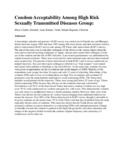Condom Acceptability Among High Risk Sexually Transmitted Diseases Group:

View/
Date
1995Author
Mwai, Charles
Kirumbi, Leah
Kimani, Violet
Sekade-Kigondu, Christine
Type
ArticleLanguage
enMetadata
Show full item recordAbstract
A knowledge, attitudes and practice ( KAP) survey was carried out in Nairobi city and Murang'a district between August 1992 and June 1993 among 360 truck drivers and their assistants (rtf/ass) prior to intervention (KAP I survey) and among 230 Td/ass after intervention (KAP 2 survey).
The aim of the study was to train peer colleagues of the drivers at the various depots along the route and in selected trucking companies to supply, educate and counsel their colleagues on the use of the condom and the risk of HlV infection.
A pre-tested questionnaire was administered by trained research assistants. There were seven and five interventional areas and non interventional areas respectively. Ten percent of those interviewed in both KAP 1 and 2 surveys underwent an indeptb interview. Key providers (peer colleagues) referred to as "Gate keepers" were trained and issued with condoms to distribute to the truck Drivers. At the same time, seminarsslectures were given on appropriate use the of condoms and on the dangers of AIDS.
Majority of the respondents were young (less than 34 years) and wuh 12 years of schooling. Knowledge of the common STDs and of ways of avoiding them was high. Use of condoms and avoidance 0/ prostitutes were the main methods mentioned to avoid contracting STDs.
The Tdsass had multiple sexual partners in the stopovers. These were young girls below 25 years of age. Tdsass risked contracting STDs because they did not use the condoms often and consistently.' Nevertheless over 50 % of the interviewed Tdsass had used a condom. Condom use was high (over 70 %) with commercial sex workers and quite low with wives.
This indicated that 'condom was used more as a prophylactic than as a family planning method.
However, there were some Tdlass who did not use the condoms for various reasons ranging from traditional beliefs to no reason for non-use.
Over 80% of the Td/ass interviewed in KAP I survey thought it advisable to be given condoms on the transit route. 70 % of the Td/ass said that they benefitted from the study especially the provision of condoms. This study has shown that the Truck drivers and their assistants continue to expose themselves to contracting STDs with minimal protection. Change of attitudes towards the condom is gradual in this high risk group but with more education and change of the negative beliefs towards the condom a higher frequency and consistency of condom use can be achieved.
Sponsorhip
World Health Organization (WHO)Publisher
Department of Community Health, University of Nairobi Institute of African Studies Kenya Medical Research Institute, Nairobi Department of Obstetrics and Gnaecology, University of Nairobi
Description
Condom Acceptability Among High Risk Sexually Transmitted Diseases Group: A Case Study of the Long Distance Truck Drivers and their Assistants
Collections
- Faculty of Health Sciences (FHS) [10387]
